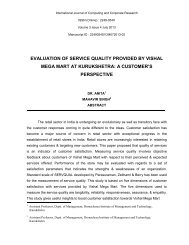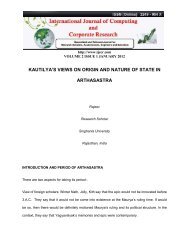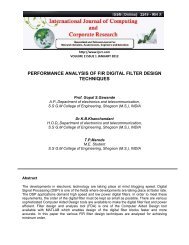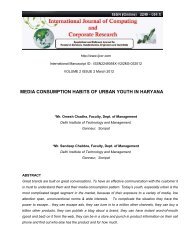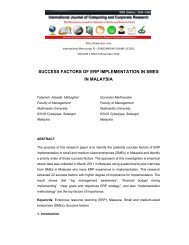artificial intelligence - International Journal of Computing and ...
artificial intelligence - International Journal of Computing and ...
artificial intelligence - International Journal of Computing and ...
Create successful ePaper yourself
Turn your PDF publications into a flip-book with our unique Google optimized e-Paper software.
<strong>International</strong> Manuscript ID : ISSN2249054X-V2I4M4-072012VOLUME 2 ISSUE 4 July 2012In 1941 an invention revolutionized every aspect <strong>of</strong> the storage <strong>and</strong> processing <strong>of</strong> information.That invention was the electronic computer. The first computers required large, separate airconditionedrooms, <strong>and</strong> were a programmer’s nightmare, involving the separate configuration <strong>of</strong>thous<strong>and</strong>s <strong>of</strong> wires to even get a program running. The 1949 innovation, the stored programcomputer, made the job <strong>of</strong> entering a program easier, <strong>and</strong> advancements in computer theorylead to computer science, <strong>and</strong> eventually Artificial <strong>intelligence</strong>. With the invention <strong>of</strong> anelectronic means <strong>of</strong> processing data, came a medium that made AI possible.3.2 THE BEGINNINGS OF AIAlthough the computer provided the technology necessary for AI, it was not until the early1950's that the link between human <strong>intelligence</strong> <strong>and</strong> machines was really observed. The firstobservations were made on the principle <strong>of</strong> feedback theory. The most familiar example <strong>of</strong>feedback theory is the thermostat. It controls the temperature <strong>of</strong> an environment by gatheringthe actual temperature <strong>of</strong> the house, comparing it to the desired temperature, <strong>and</strong> respondingby turning the heat up or down. What was so important about this research into feedback loopswas that it theorized that all intelligent behavior was the result <strong>of</strong> feedback mechanisms. Thisdiscovery influenced much <strong>of</strong> the early development <strong>of</strong> AI.In late 1955 The Logic Theorist, was developed considered by many to be the first AI program.The program, representing each problem as a tree model, would attempt to solve it by selectingthe branch that would most likely result in the correct conclusion. The impact that it made onboth the public <strong>and</strong> the field <strong>of</strong> AI has made it a crucial stepping stone in developing the AI field.In 1956 John McCarthy regarded as the father <strong>of</strong> AI, organized a conference to draw the talent<strong>and</strong> expertise <strong>of</strong> others interested in machine <strong>intelligence</strong> for a month <strong>of</strong> brainstorming. Heinvited them to Vermont for "The Dartmouth summer research project on <strong>artificial</strong> <strong>intelligence</strong>."From that point on, because <strong>of</strong> McCarthy, the field would be known as Artificial <strong>intelligence</strong>.Although not a huge success, the Dartmouth conference did bring together the founders in AI,<strong>and</strong> served to lay the groundwork for the future <strong>of</strong> AI research.4. PROBLEMS RELATED TO ARTIFICIAL INTELLIGENCE
<strong>International</strong> Manuscript ID : ISSN2249054X-V2I4M4-072012VOLUME 2 ISSUE 4 July 2012"Can a machine act intelligently?" is still an open problem. Taking "A machine can actintelligently" as a working hypothesis, many researchers have attempted to build such amachine.The general problem <strong>of</strong> simulating (or creating) <strong>intelligence</strong> has been broken down into anumber <strong>of</strong> specific sub-problems. These consist <strong>of</strong> particular traits or capabilities thatresearchers would like an intelligent system to display. Some <strong>of</strong> the most important traits aredescribed below:4.1 DEDUCTION, REASONING AND PROBLEM SOLVINGEarly AI researchers developed algorithms that imitated the step-by-step reasoning that humansuse when they solve puzzles or make logical deductions. By the late 1980s <strong>and</strong> '90s, AIresearch had also developed highly successful methods for dealing with uncertain or incompleteinformation, employing concepts from probability <strong>and</strong> economics.For difficult problems, most <strong>of</strong> these algorithms can require enormous computational resources— most experience a "combinatorial explosion": the amount <strong>of</strong> memory or computer timerequired becomes astronomical when the problem goes beyond a certain size. The search formore efficient problem-solving algorithms is a high priority for AI research.Human beings solve most <strong>of</strong> their problems using fast, intuitive judgments rather than theconscious, step-by-step deduction that early AI research was able to model. AI has made someprogress at imitating this kind <strong>of</strong> "sub-symbolic" problem solving: embodied agent approachesemphasize the importance <strong>of</strong> sensorimotor skills to higher reasoning; neural net researchattempts to simulate the structures inside human <strong>and</strong> animal brains that give rise to this skill.4.2 KNOWLEDGE REPRESENTATIONKnowledge representation <strong>and</strong> knowledge engineering are central to AI research. Many <strong>of</strong> theproblems machines are expected to solve will require extensive knowledge about the world.Among the things that AI needs to represent are: objects, properties, categories <strong>and</strong> relations
<strong>International</strong> Manuscript ID : ISSN2249054X-V2I4M4-072012VOLUME 2 ISSUE 4 July 2012between objects, situations, events, states <strong>and</strong> time; causes <strong>and</strong> effects; knowledge aboutknowledge (what we know about what other people know); <strong>and</strong> many other, less wellresearched domains.Among the most difficult problems in knowledge representations are:• Default reasoning <strong>and</strong> the qualification problem-Many <strong>of</strong> the things people know take the form <strong>of</strong> "working assumptions." For example, ifa bird comes up in conversation, people typically picture an animal that is fist sized,sings, <strong>and</strong> flies. None <strong>of</strong> these things are true about all birds. John McCarthy identifiedthis problem in 1969 as the qualification problem: for any commonsense rule that AIresearchers care to represent, there tend to be a huge number <strong>of</strong> exceptions. Almostnothing is simply true or false in the way that abstract logic requires.• The sub-symbolic form <strong>of</strong> some commonsense knowledge-Much <strong>of</strong> what people know is not represented as "facts" or "statements" that they couldexpress verbally. For example, a chess master will avoid a particular chess positionbecause it "feels too exposed" or an art critic can take one look at a statue <strong>and</strong> instantlyrealize that it is a fake. These are intuitions or tendencies that are represented in thebrain non-consciously <strong>and</strong> sub-symbolically. Knowledge like this supports <strong>and</strong> providesa context for symbolic, conscious knowledge. As with the related problem <strong>of</strong> subsymbolicreasoning, it is hoped that situated AI or computational <strong>intelligence</strong> will provideways to represent this kind <strong>of</strong> knowledge.4.3 PLANNINGIntelligent agents must be able to set goals <strong>and</strong> achieve them. They need a way to visualize thefuture (they must have a representation <strong>of</strong> the state <strong>of</strong> the world <strong>and</strong> be able to makepredictions about how their actions will change it) <strong>and</strong> be able to make choices that maximizethe utility <strong>of</strong> the available choices.4.4 LEARNING
<strong>International</strong> Manuscript ID : ISSN2249054X-V2I4M4-072012VOLUME 2 ISSUE 4 July 2012Machine learning has been central to AI research from the beginning. In 1956, at the originalDartmouth AI summer conference, a report was written on unsupervised probabilistic machinelearning: "An Inductive Inference Machine". Unsupervised learning is the ability to find patternsin a stream <strong>of</strong> input. Supervised learning includes both classification <strong>and</strong> numerical regression.Classification is used to determine what category something belongs in, after seeing a number<strong>of</strong> examples <strong>of</strong> things from several categories. Regression is the attempt to produce a functionthat describes the relationship between inputs <strong>and</strong> outputs <strong>and</strong> predicts how the outputs shouldchange as the inputs change.4.5 NATURAL LANGUAGE PROCESSINGNatural language processing gives machines the ability to read <strong>and</strong> underst<strong>and</strong> the languagesthat humans speak. A sufficiently powerful natural language processing system would enablethe acquisition <strong>of</strong> knowledge directly from human-written sources, such as Internet texts. Somestraightforward applications <strong>of</strong> natural language processing include information retrieval<strong>and</strong> machine translation.5. APPROACHES TOWARDS ARTIFICIAL INTELLIGENCEThere is no established unifying theory or paradigm that guides AI research. Researchersdisagree about many issues. A few <strong>of</strong> the longest st<strong>and</strong>ing questions that have remainedunanswered are these: Should <strong>artificial</strong> <strong>intelligence</strong> simulate natural <strong>intelligence</strong> bystudying psychology or neurology? Or is human biology as irrelevant to AI research as birdbiology is to aeronautical engineering? Can intelligent behavior be described using simple,elegant principles such as logic or optimization? Or does it necessarily require solving a largenumber <strong>of</strong> completely unrelated problems? Can <strong>intelligence</strong> be reproduced using high-levelsymbols, similar to words <strong>and</strong> ideas? Or does it require "sub-symbolic" processing? No singlealgorithm can answer all these questions .However there are some widely accepted approacheswhich are listed below:5.1 CYBERNETICS AND BRAIN SIMULATION
<strong>International</strong> Manuscript ID : ISSN2249054X-V2I4M4-072012VOLUME 2 ISSUE 4 July 2012There is currently no consensus on how closely the brain should be simulated.In the 1940s <strong>and</strong> 1950s, a number <strong>of</strong> researchers explored the connectionbetween neurology, information theory, <strong>and</strong> cybernetics. Some <strong>of</strong> them built machines that usedelectronic networks to exhibit rudimentary <strong>intelligence</strong>, such as W. Grey Walter's turtles <strong>and</strong>the Johns Hopkins Beast. Many <strong>of</strong> these researchers gathered for meetings <strong>of</strong> the TeleologicalSociety at Princeton University <strong>and</strong> the Ratio Club in Engl<strong>and</strong>. By 1960, this approach waslargely ab<strong>and</strong>oned, although elements <strong>of</strong> it were revived in the 1980s.5.2 SYMBOLICWhen access to digital computers became possible in the middle 1950s, AI research began toexplore the possibility that human <strong>intelligence</strong> could be reduced to symbol manipulation. Theresearch was centered in three institutions: CMU, Stanford <strong>and</strong> MIT, <strong>and</strong> each one developedits own style <strong>of</strong> research. John Haugel<strong>and</strong> named these approaches to AI "good old fashionedAI" or "GOFAI".5.3 COGNITIVE SIMULATIONResearchers <strong>and</strong> economists studied human problem-solving skills <strong>and</strong> attempted to formalizethem, <strong>and</strong> their work laid the foundations <strong>of</strong> the field <strong>of</strong> <strong>artificial</strong> <strong>intelligence</strong>, as well as cognitivescience. The results <strong>of</strong> psychological experiments were used to develop programs thatsimulated the techniques that people use to solve problems.5.4 LOGIC-BASEDUnlike other researchers, John McCarthy felt that machines did not need to simulate humanthought, but should instead try to find the essence <strong>of</strong> abstract reasoning <strong>and</strong> problem solving,regardless <strong>of</strong> whether people used the same algorithms. His laboratory at Stanford focused onusing formal logic to solve a wide variety <strong>of</strong> problems, including knowledgerepresentation, planning <strong>and</strong> learning. Logic was also focus <strong>of</strong> the work at the University <strong>of</strong>
<strong>International</strong> Manuscript ID : ISSN2249054X-V2I4M4-072012VOLUME 2 ISSUE 4 July 2012Edinburgh <strong>and</strong> elsewhere in Europe which led to the development <strong>of</strong> the programminglanguage Prolog <strong>and</strong> the science <strong>of</strong> logic programming.5.5 "ANTI-LOGIC" OR "SCRUFFY"Researchers at MIT found that solving difficult problems in vision <strong>and</strong> natural languageprocessing required ad-hoc solutions – they argued that there was no simple <strong>and</strong> generalprinciple that would capture all the aspects <strong>of</strong> intelligent behavior. This logic was described as"anti-logic" or "scruffy" (as opposed to the "neat" paradigms at CMU <strong>and</strong>Stanford). Commonsense knowledge bases are an example <strong>of</strong> "scruffy" AI, since they must bebuilt by h<strong>and</strong>, one complicated concept at a time.5.6 KNOWLEDGE-BASEDWhen computers with large memories became available around 1970, researchers from allthree traditions began to build knowledge into AI applications. This "knowledge revolution" led tothe development <strong>and</strong> deployment <strong>of</strong> expert systems, the first truly successful form <strong>of</strong> AIs<strong>of</strong>tware. The knowledge revolution was also driven by the realization that enormous amounts<strong>of</strong> knowledge would be required by many simple AI applications.5.7 SUB-SYMBOLICDuring the 1960s, symbolic approaches had achieved great success at simulating high-levelthinking in small demonstration programs. By the 1980s, however, progress in symbolic AIseemed to stall <strong>and</strong> many believed that symbolic systems would never be able to imitate all theprocesses <strong>of</strong> human cognition, especially perception, robotics, learning <strong>and</strong> pattern recognition.A number <strong>of</strong> researchers began to look into "sub-symbolic" approaches to specific AI problems.Researchers from the related field <strong>of</strong> robotics rejected symbolic AI <strong>and</strong> focused on the basicengineering problems that would allow robots to move <strong>and</strong> survive. Their work revived the nonsymbolicviewpoint <strong>of</strong> the early researchers <strong>of</strong> the 50s <strong>and</strong> reintroduced the use <strong>of</strong> controltheory in AI.
<strong>International</strong> Manuscript ID : ISSN2249054X-V2I4M4-072012VOLUME 2 ISSUE 4 July 20125.8 STATISTICALIn the 1990s, AI researchers developed sophisticated mathematical tools to solve specificproblems. These tools were truly scientific, in the sense that their results were both measurable<strong>and</strong> verifiable. Also they have been responsible for many <strong>of</strong> AI's recent successes. The sharedmathematical language has also permitted a high level <strong>of</strong> collaboration with more establishedfields (like mathematics, economics or operations research). This movement is described asnothing less than a "revolution" <strong>and</strong> "the victory <strong>of</strong> the neats." Critics argue that thesetechniques are too focused on particular problems <strong>and</strong> have failed to address the long term goal<strong>of</strong> general <strong>intelligence</strong>.6. INTEGRATING THE APPROACHESAn intelligent agent is a system that perceives its environment <strong>and</strong> takes actions whichmaximize its chances <strong>of</strong> success. The simplest intelligent agents are programs that solvespecific problems. More complicated agents include human beings <strong>and</strong> organizations <strong>of</strong> humanbeings (such as firms). The paradigm gives researchers license to study isolated problems <strong>and</strong>find solutions that are both verifiable <strong>and</strong> useful, without agreeing on one single approach. Anagent that solves a specific problem can use any approach that works — some agents aresymbolic <strong>and</strong> logical, some are sub-symbolic neural networks <strong>and</strong> others may use newapproaches. The paradigm also gives researchers a common language to communicate withother fields—such as decision theory <strong>and</strong> economics—that also use concepts <strong>of</strong> abstractagents.7. TOOLS USED IN ARTIFICIAL INTELLIGENCEIn the course <strong>of</strong> 50 years <strong>of</strong> research, AI has developed a large number <strong>of</strong> tools to solve themost difficult problems in computer science. A few <strong>of</strong> the most general <strong>of</strong> these methods arediscussed below.7.1 SEARCH AND OPTIMIZATION
<strong>International</strong> Manuscript ID : ISSN2249054X-V2I4M4-072012VOLUME 2 ISSUE 4 July 2012Many problems in AI can be solved in theory by intelligently searching through many possiblesolutions that is reasoning can be reduced to performing a search. For example, logical pro<strong>of</strong>can be viewed as searching for a path that leads from premises to conclusions, where eachstep is the application <strong>of</strong> an inference rule. Planning algorithms search through trees <strong>of</strong> goals<strong>and</strong> sub goals, attempting to find a path to a target goal, a process called means-endsanalysis. Robotics algorithms for moving limbs <strong>and</strong> grasping objects use localsearches in configuration space. Many learning algorithms use search algorithms basedon optimization.Simple exhaustive searches are rarely sufficient for most real world problems: the searchspace (the number <strong>of</strong> places to search) quickly grows to astronomical numbers. The result is asearch that is too slow or never completes. The solution, for many problems, is to use"heuristics" or "rules <strong>of</strong> thumb" that eliminate choices that are unlikely to lead to the goal (called"pruning the search tree"). Heuristics supply the program with a "best guess" for the path onwhich the solution lies.A very different kind <strong>of</strong> search came to prominence in the 1990s, based on the mathematicaltheory <strong>of</strong> optimization. For many problems, it is possible to begin the search with some form <strong>of</strong> aguess <strong>and</strong> then refine the guess incrementally until no more refinements can be made. Thesealgorithms can be visualized as blind hill climbing: we begin the search at a r<strong>and</strong>om point on thel<strong>and</strong>scape, <strong>and</strong> then, by jumps or steps, we keep moving our guess uphill, until we reach thetop.Evolutionary computation uses a form <strong>of</strong> optimization search. For example, they may begin witha population <strong>of</strong> organisms (the guesses) <strong>and</strong> then allow them to mutate <strong>and</strong>recombine, selecting only the fittest to survive each generation (refining the guesses). Forms<strong>of</strong> evolutionary computation include swarm <strong>intelligence</strong> algorithms (such as antcolony or particle swarm optimization) <strong>and</strong> evolutionary algorithms (such as geneticalgorithms <strong>and</strong> genetic programming).7.2 LOGIC
<strong>International</strong> Manuscript ID : ISSN2249054X-V2I4M4-072012VOLUME 2 ISSUE 4 July 2012Logic is used for knowledge representation <strong>and</strong> problem solving, but it can be applied to otherproblems as well. Several different forms <strong>of</strong> logic are used in AIresearch. Propositional or sentential logic is the logic <strong>of</strong> statements which can be true orfalse. First-order logic also allows the use <strong>of</strong> quantifiers <strong>and</strong> predicates, <strong>and</strong> can express factsabout objects, their properties, <strong>and</strong> their relations with each other. Fuzzy logic is a version <strong>of</strong>first-order logic which allows the truth <strong>of</strong> a statement to be represented as a value between 0<strong>and</strong> 1, rather than simply true (1) or false (0). Fuzzy systems can be used for uncertainreasoning <strong>and</strong> have been widely used in modern industrial <strong>and</strong> consumer product controlsystems. Subjective logic models uncertainty in a different <strong>and</strong> more explicit manner than fuzzylogic:a given binomial opinion satisfies belief + disbelief + uncertainty = 1 within a Betadistribution. By this method, ignorance can be distinguished from probabilistic statements thatan agent makes with high confidence.Default logics, non-monotonic logics <strong>and</strong> circumscription are forms <strong>of</strong> logic designed to help withdefault reasoning <strong>and</strong> the qualification problem. Several extensions <strong>of</strong> logic have been designedto h<strong>and</strong>le specific domains <strong>of</strong> knowledge, such as description logics, situation calculus, eventcalculus <strong>and</strong> fluent calculus (for representing events <strong>and</strong> time), causal calculus; belief calculus,<strong>and</strong> modal logics.7.3 PROBABILISTIC METHODS FOR UNCERTAIN REASONINGMany problems in AI (in reasoning, planning, learning, perception <strong>and</strong> robotics) require theagent to operate with incomplete or uncertain information. AI researchers have devised anumber <strong>of</strong> powerful tools to solve these problems using methods from probability theory<strong>and</strong> economics.Bayesian networks are a very general tool that can be used for a large number <strong>of</strong> problems:reasoning (using the Bayesian inference algorithm), learning (using the expectationmaximizationalgorithm), planning (using decision networks) <strong>and</strong> perception (using dynamicBayesian networks). Probabilistic algorithms can also be used for filtering, prediction, smoothing<strong>and</strong> finding explanations for streams <strong>of</strong> data, helping perception systems to analyze processesthat occur over time.
<strong>International</strong> Manuscript ID : ISSN2249054X-V2I4M4-072012VOLUME 2 ISSUE 4 July 2012A key concept from the science <strong>of</strong> economics is "utility": a measure <strong>of</strong> how valuable somethingis to an intelligent agent. Precise mathematical tools have been developed that analyze how anagent can make choices <strong>and</strong> plan, using decision theory, decision analysis, information valuetheory. These tools include models such as dynamic decision networks, gametheory <strong>and</strong> mechanism design.7.4 CLASSIFIERS AND STATISTICAL LEARNING METHODSThe simplest AI applications can be divided into two types: classifiers ("if shiny then diamond")<strong>and</strong> controllers ("if shiny then pick up"). Controllers do however also classify conditions beforeinferring actions, <strong>and</strong> therefore classification forms a central part <strong>of</strong> many AIsystems. Classifiers are functions that use pattern matching to determine a closest match. Theycan be tuned according to examples, making them very attractive for use in AI. These examplesare known as observations or patterns. In supervised learning, each pattern belongs to a certainpredefined class. A class can be seen as a decision that has to be made. All the observationscombined with their class labels are known as a data set. When a new observation is received,that observation is classified based on previous experience.A classifier can be trained in various ways; there are many statistical <strong>and</strong> machinelearning approaches. The most widely used classifiers are the neural network, kernelmethods such as the support vector machine ,k-nearest neighbor algorithm, Gaussian mixturemodel, naive Bayes classifier, <strong>and</strong> decision tree. The performance <strong>of</strong> these classifiers havebeen compared over a wide range <strong>of</strong> tasks. Classifier performance depends greatly on thecharacteristics <strong>of</strong> the data to be classified. There is no single classifier that works best on allgiven problems. This is also referred to as the "no free lunch" theorem. Determining a suitableclassifier for a given problem is still more an art than science.7.5 NEURAL NETWORKSA neural network is an interconnected group <strong>of</strong> nodes, akin to the vast network <strong>of</strong> neurons in thehuman brain. The study <strong>of</strong> <strong>artificial</strong> neural networks began in the decade before the field AIresearch was founded, in the work <strong>of</strong> Walter Pitts <strong>and</strong> Warren McCullough. Other important
<strong>International</strong> Manuscript ID : ISSN2249054X-V2I4M4-072012VOLUME 2 ISSUE 4 July 2012early researchers were Frank Rosenblatt, who invented the perceptron <strong>and</strong> Paul Werbos whodeveloped the backpropagation algorithm.The main categories <strong>of</strong> neural networks are acyclic or feedforward neural networks (where thesignal passes in only one direction) <strong>and</strong> recurrent neural networks (which allow feedback).Among the most popular feedforward networks are perceptrons, multi-layerperceptrons <strong>and</strong> radial basis networks. Among recurrent networks, the most famous isthe Hopfield net, a form <strong>of</strong> attractor network, which was first described by John Hopfield in1982. Neural networks can be applied to the problem <strong>of</strong> intelligent control (for robotics)or learning, using such techniques as competitive learning.8. BRANCHES OF ARTIFICIAL INTELLIGENCESome <strong>of</strong> the branches <strong>of</strong> <strong>artificial</strong> <strong>intelligence</strong> are briefly described below. These are not thecomplete number <strong>of</strong> branches because some <strong>of</strong> the branches have not been studied yet. Alsosome <strong>of</strong> these may be regarded as concepts rather than full branches.8.1 LOGICAL AIWhat a program knows about the world in general the facts <strong>of</strong> the specific situation in which itmust act, <strong>and</strong> its goals are all represented by sentences <strong>of</strong> some mathematical logicallanguage. The program decides what to do by inferring that certain actions are appropriate forachieving its goals. The first article proposing this was [McC59]. [McC89], [McC96b], [Sha97]are more recent texts which list some <strong>of</strong> the concepts involved in logical AI.8.2 SEARCHAI programs <strong>of</strong>ten examine large numbers <strong>of</strong> possibilities, e.g. moves in a chess game orinferences by a theorem proving program. Discoveries are continually made about how to dothis more efficiently in various domains.8.3 PATTERN RECOGNITION
<strong>International</strong> Manuscript ID : ISSN2249054X-V2I4M4-072012VOLUME 2 ISSUE 4 July 2012When a program makes observations <strong>of</strong> some kind, it is <strong>of</strong>ten programmed to compare what itsees with a pattern. For example, a vision program may try to match a pattern <strong>of</strong> eyes <strong>and</strong> anose in a scene in order to find a face. More complex patterns, e.g. in a natural language text, ina chess position, or in the history <strong>of</strong> some event are also studied. These more complex patternsrequire quite different methods than do the simple patterns that have been studied the most.8.4 REPRESENTATIONFacts about the world have to be represented in some way. Usually languages <strong>of</strong> somemathematical logic are used for this kind <strong>of</strong> representation.8.5 INFERENCEFrom some facts, others can be inferred. Mathematical logical deduction is adequate for somepurposes, but new methods <strong>of</strong> non-monotonic inference have been added to logic since the1970s. The simplest kind <strong>of</strong> non-monotonic reasoning is default reasoning in which a conclusionis to be inferred by default, but the conclusion can be withdrawn if there is evidence to thecontrary. For example, when we hear <strong>of</strong> a bird, we can infer that it can fly, but this conclusioncan be reversed when we hear that it is a penguin. It is the possibility that a conclusion mayhave to be withdrawn that constitutes the non-monotonic character <strong>of</strong> the reasoning. Ordinarylogical reasoning is monotonic in that the set <strong>of</strong> conclusions that can be drawn from a set <strong>of</strong>premises is a monotonic increasing function <strong>of</strong> the premises. Circumscription is another form <strong>of</strong>non-monotonic reasoning.8.6 COMMON SENSE KNOWLEDGE AND REASONINGThis is the area in which AI is farthest from human-level, in spite <strong>of</strong> the fact that it has been anactive research area since the 1950s. While there has been considerable progress, e.g. indeveloping systems <strong>of</strong> non-monotonic reasoning <strong>and</strong> theories <strong>of</strong> action, yet more new ideas areneeded. For example the Cyc system contains a large but spotty collection <strong>of</strong> common sensefacts.
<strong>International</strong> Manuscript ID : ISSN2249054X-V2I4M4-072012VOLUME 2 ISSUE 4 July 20128.7 LEARNING FROM EXPERIENCEComputer programs can learn from experience <strong>and</strong> practice. The approaches to AI basedon connectionism <strong>and</strong> neural nets specialize in this. There is also learning <strong>of</strong> laws expressed inlogic. [Mit97] is a comprehensive undergraduate text on machine learning. Programs can onlylearn what facts or behaviors their formalisms can represent, <strong>and</strong> unfortunately learningsystems are almost all based on very limited abilities to represent information.8.8 PLANNINGPlanning programs start with general facts about the world (especially facts about the effects <strong>of</strong>actions), facts about the particular situation <strong>and</strong> a statement <strong>of</strong> a goal. From these, theygenerate a strategy for achieving the goal. In the most common cases, the strategy is just asequence <strong>of</strong> actions.8.9 HEURISTICSA heuristic is a way <strong>of</strong> trying to discover something or an idea imbedded in a program. The termis used variously in AI. Heuristic functions are used in some approaches to search to measurehow far a node in a search tree seems to be from a goal. Heuristic predicates compares twonodes in a search tree to see if one is better than the other, i.e. constitutes an advance towardthe goal.REFERENCES• http://www-formal.stanford.edu/jmc/whatisai/node1.html• http://www-formal.stanford.edu/jmc/whatisai/node2.html
<strong>International</strong> Manuscript ID : ISSN2249054X-V2I4M4-072012VOLUME 2 ISSUE 4 July 2012• http://www-formal.stanford.edu/jmc/whatisai/• http://www-formal.stanford.edu/jmc/whatisai/node3.html• http://www-formal.stanford.edu/jmc/whatisai/node4.html• http://en.wikipedia.org/wiki/Artificial_<strong>intelligence</strong>• http://future.wikia.com/wiki/Artificial_Intelligence





